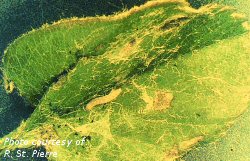Saskatoon Bud Moth (Epinotia Bicordana)

Saskatoon bud moth larva within folded Leaf
Host Plants And Distribution
Saskatoon is the primary host. This insect is found throughout the Prairie Provinces.
Biology
Adults are small greyish-black to brown moths that emerge during early April. After mating, females lay eggs at the base of buds and in crevices in the bark of twigs. Eggs hatch after about two weeks (early May) and the young larvae move to the developing flower buds to begin feeding. As feeding continues, the yellow to pale-green larvae web together expanding shoots. Larvae complete development at about the same time as petal drop. Upon reaching maturity, larvae move to leaf material and tie them together to form a protected cell that they will remain in as larvae until the early fall. In early fall, pupation occurs and this is the stage that the insect overwinters in.
Symptoms And Damage
Early in the season, flower buds will have tiny holes (1 mm) and may be oozing droplets. Discoloured (yellow) buds may fall off when touched. Later in the season folded leaves may be observed that contain a fully developed larvae and some webbing. Damage is caused by the feeding activity of the larvae on the bud. They are capable of destroying entire buds and in years of high infestation, the bud moth may destroy virtually all of the buds.
Scouting Techniques
Early-season (early April) monitoring of adult moth activity may not be practical. Although it will not help in the current season, monitoring of foliage for folded leaves may indicate population levels of the bud moth for the following year.
Economic Thresholds
No economic thresholds have been established for this insect.
